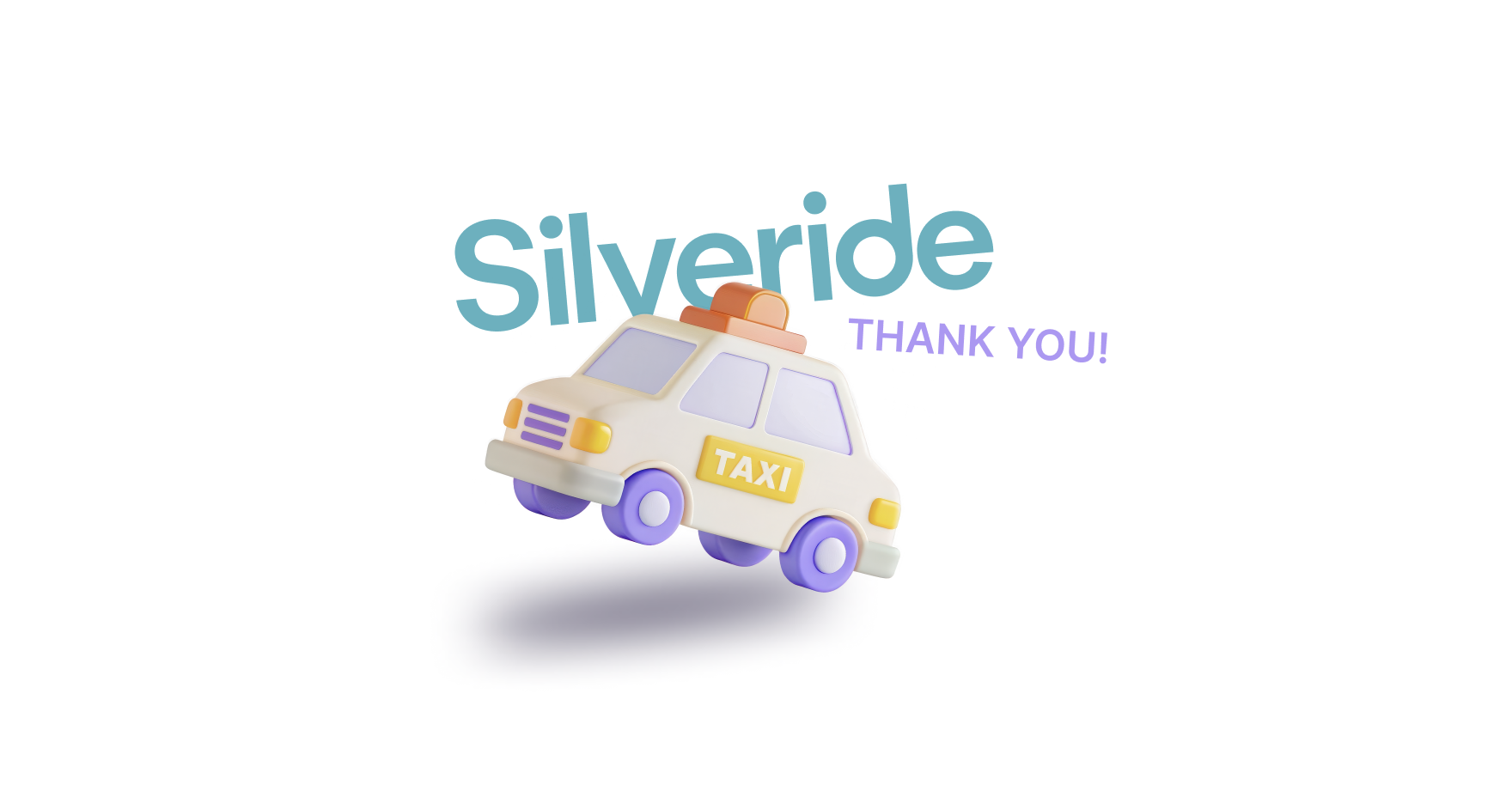Silveride

Role
Product designer
Product designer
Timeline
June 2024 - Aug 2024
June 2024 - Aug 2024
Responsibilities
UX Research
Design Thinking
Wireframe
Prototyping
Branding
Interface Design
UX Research
Design Thinking
Wireframe
Prototyping
Branding
Interface Design
Tools
Figma
Figma Jam
Adobe Photoshop
Adobe Firefly
Figma
Figma Jam
Adobe Photoshop
Adobe Firefly
Project Overview
Challeges
Redesign a taxi-hailing app accommodating physical and cognitive needs of seniors to ensure a more accessible and stress-free experience.
Opportunity
Improve the service flow of existing taxi-hailing apps in Korea and design interfaces that attract a broader range of age groups.
Project Background
How stressful would it be,
if you can’t grab a taxi
after waving for it for hours,
on an extremely hot summer day?
if you can’t grab a taxi
after waving for it for hours,
on an extremely hot summer day?
This project was inspired by my grandparents, who once stood by the road for an hour in the summer heat, unable to hail a taxi because all were booked through the "Kakao T" app. Although my grandfather tried using the app, he found it too complicated and frustrating, eventually giving up.
In our aging society, digital exclusion among seniors is not just their problem—it could become ours. Addressing this issue is vital for fostering a more inclusive society, where seniors can access essential services without being left behind, especially during extreme weather conditions.
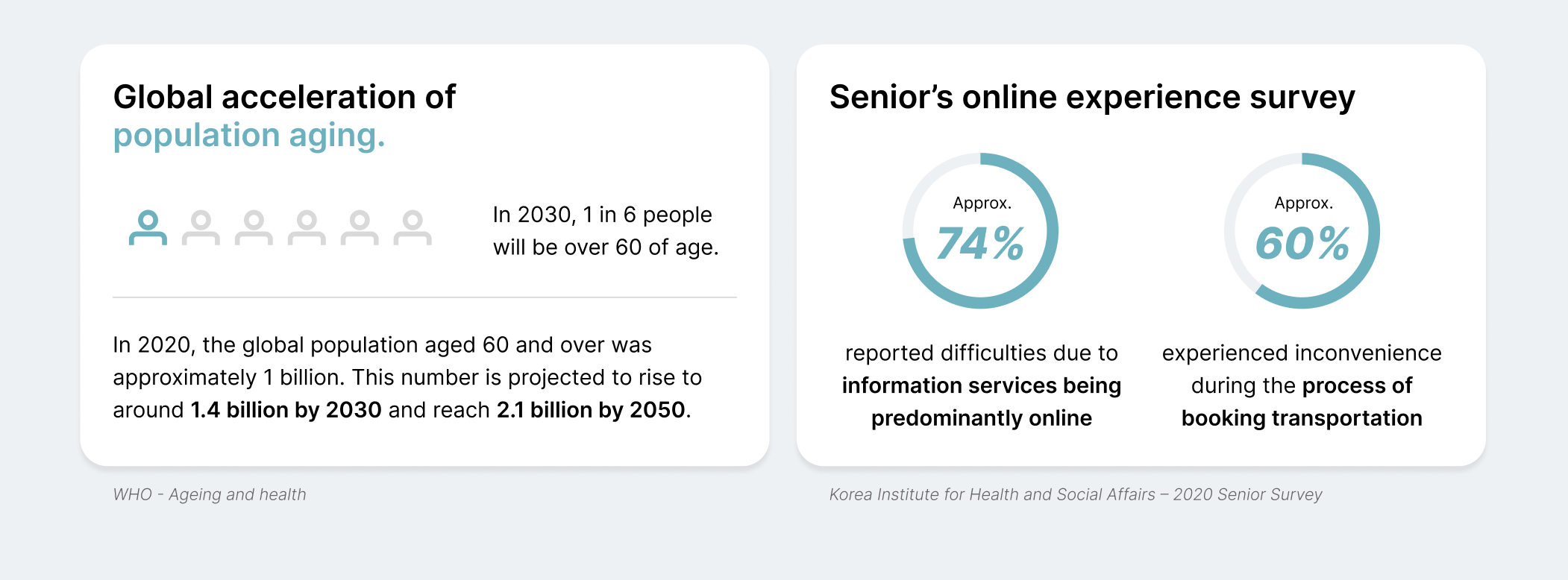
Process

RESEARCH
Desk Research
Research Objectives
- Investigate precise statistics on the increasing proportion of the elderly population.
- Examine the current status of public transportation usage among seniors.
- Analyze seniors' usage and satisfaction levels with smartphone applications.
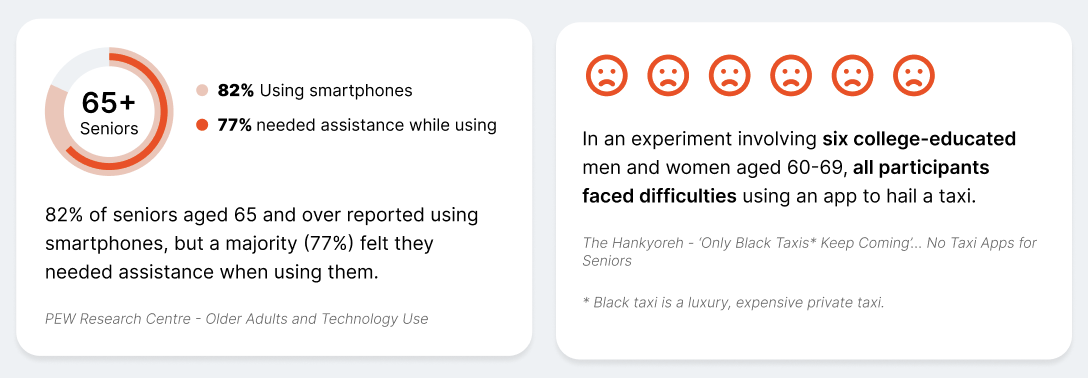
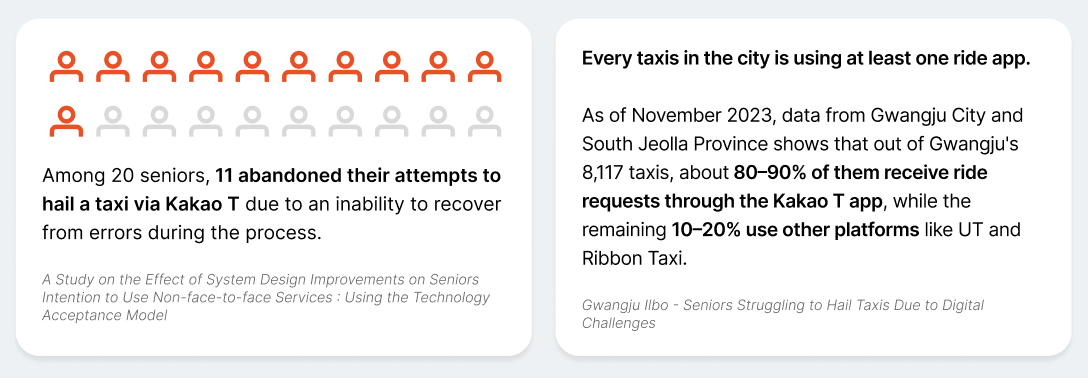
* Please note that the research above was done in Korean then translated into English.
RESEARCH
User Interviews
To gain deeper insights into the experiences with taxi-hailing apps, I interviewed three individuals of different age groups: two senior users, one in their late 70s and another in their mid-60s, as well as a user in their 50s whose parents are attempting to use the app.
Questions included:
- Do you use taxi-hailing apps like 'Kakao T'?
- What does the process look like when you are using the app?
- If you are not using the app, how do you usually get a taxi when needed?
- Are you satisfied with the current method?
- What do you do when you fail get a taxi at all?
- Other than taxi apps, do you use any smartphone applicationsat all?
- If taxi apps were redesigned in this way, would you be willing to use them?
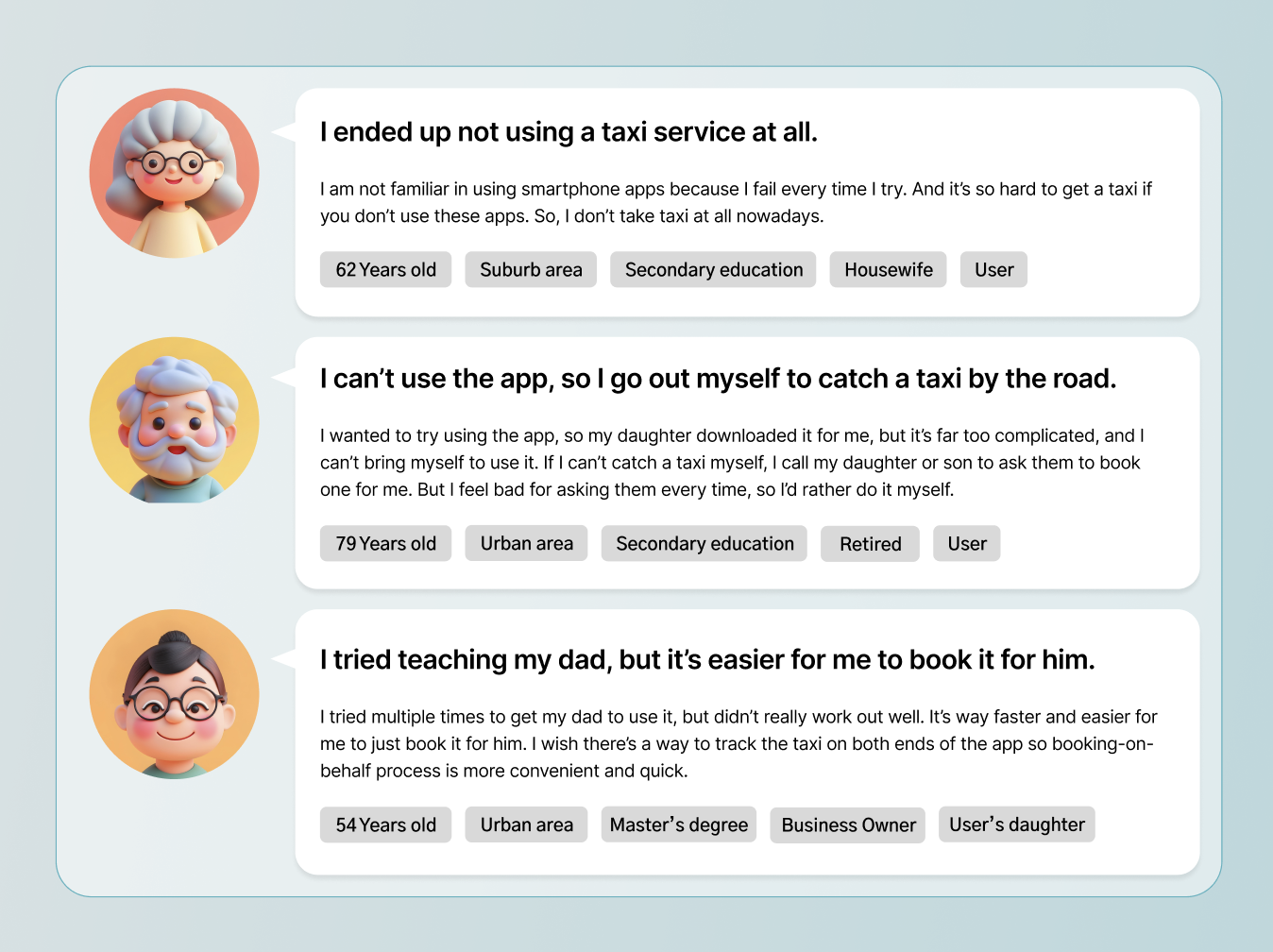
RESEARCH
Competitive Analysis
My analysis is based around what kind of services are offered by the apps in the same category, and how intuitively they are built within the platform.
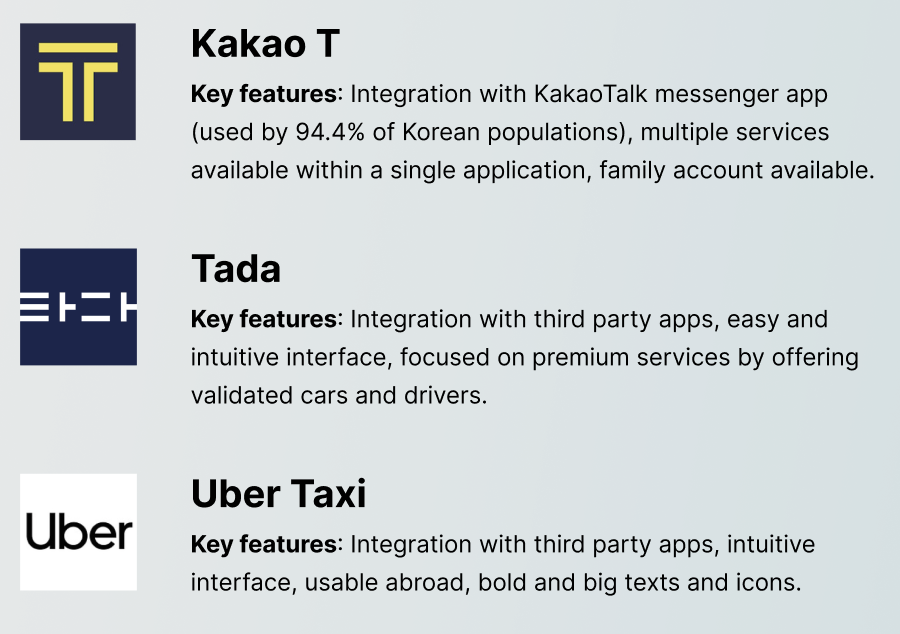
⚠️️ Please be mindful that user preferences may vary, and the pros and cons are based on the general observation of the platform.
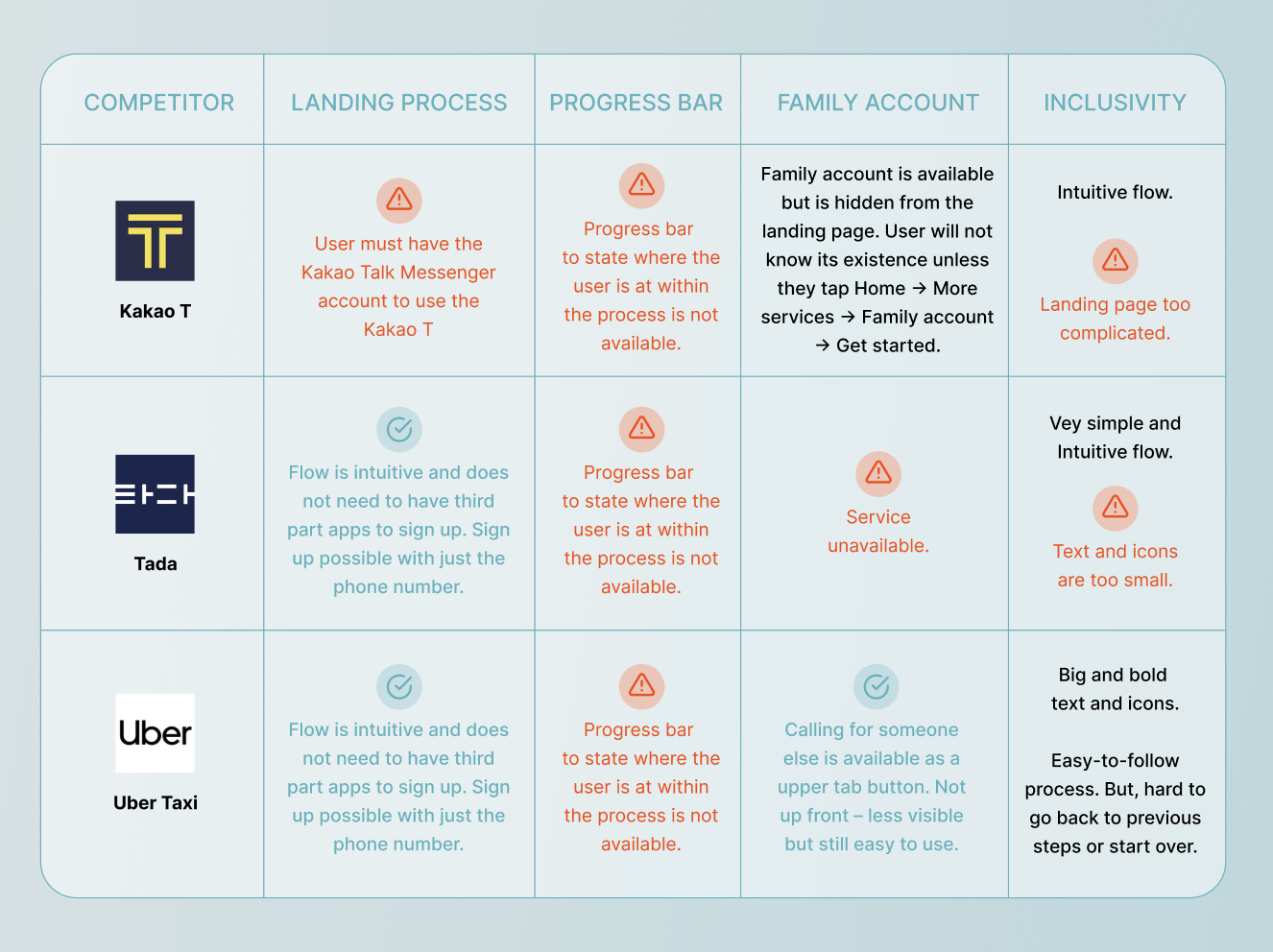
RESEARCH
Identifying problems
Problems in the existing services:
Initial Complexity Barrier:
Most senior users feel overwhelmed by the complexity of the app's first screen and hesitate to proceed further.Difficulty in fixing the error:
Most seniors had trouble in the error recovery. Some had to restart the app entirely to fix a little error.Overuse of cryptic symbols and icons:
Symbols and icons that are commonly understood by the majority may not be communicated correctly by the seniors.Lost in the process:
Frustration in lack of clarity in stating the progress towards the completion, which caused a loss in motivation.Dynamic Input Challenges: Frequent and overly fluid interactions, such as entering and modifying addresses, are disruptive for older users.
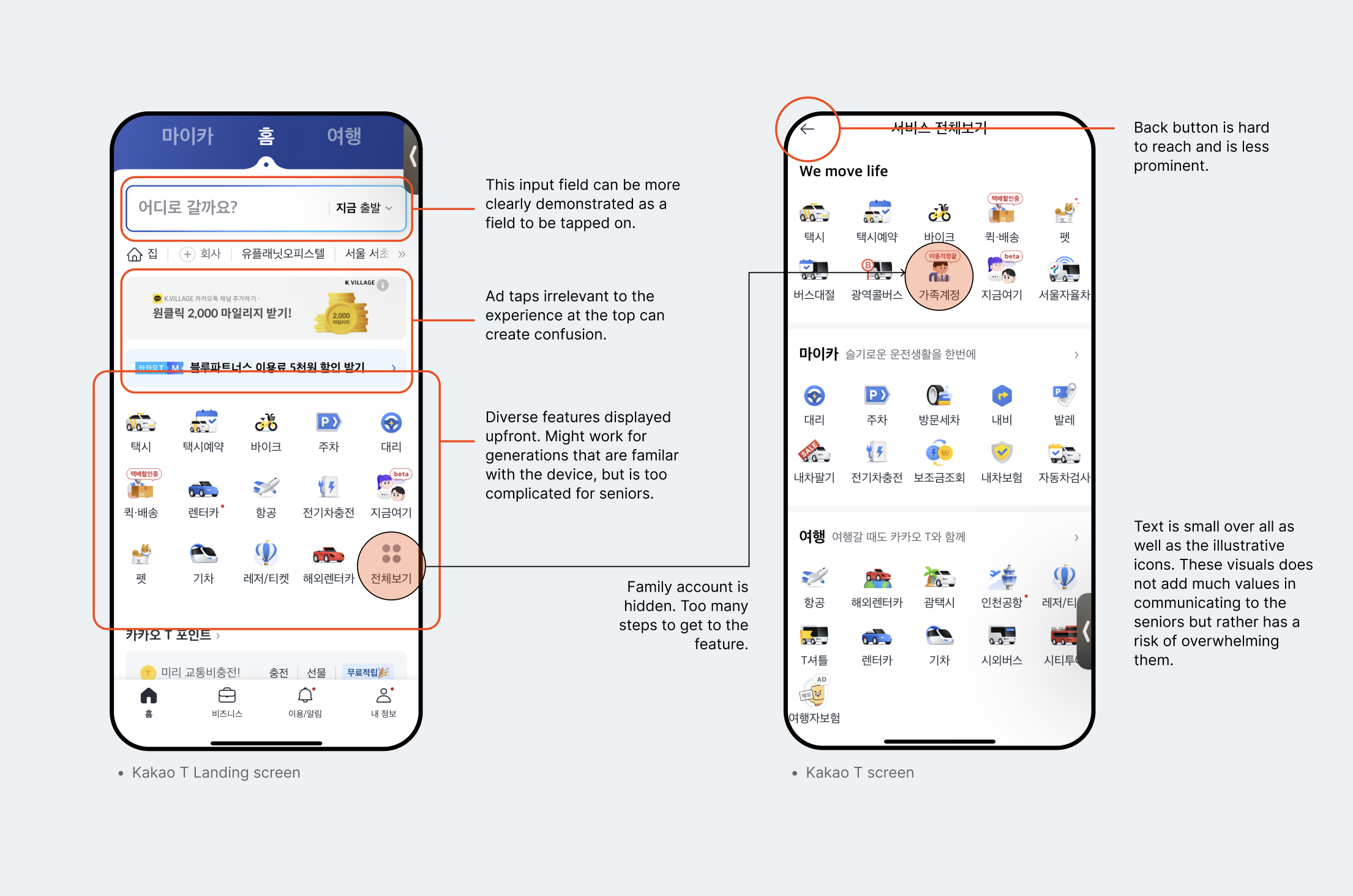
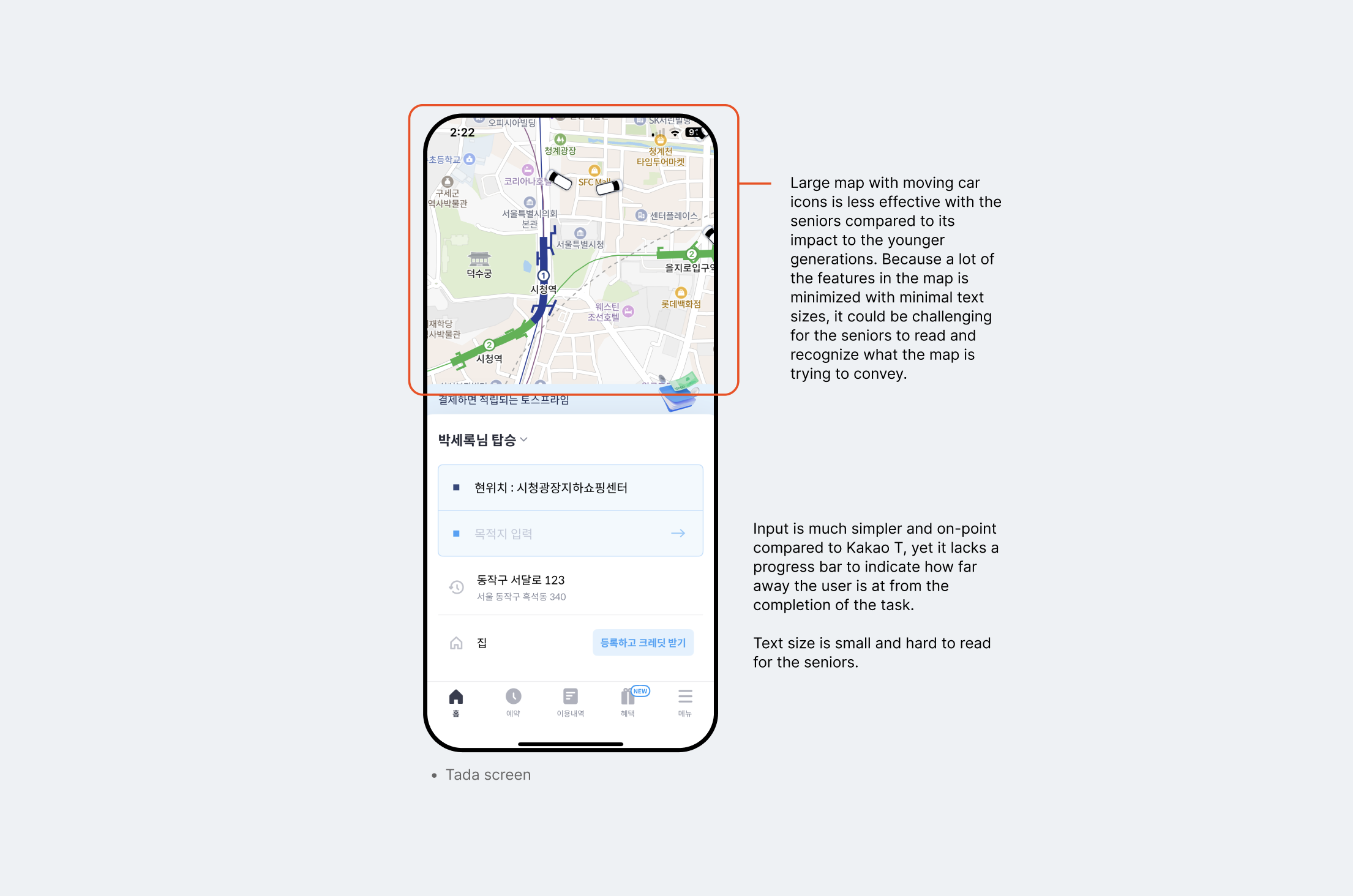
SYNTHESIS
Defining Problems
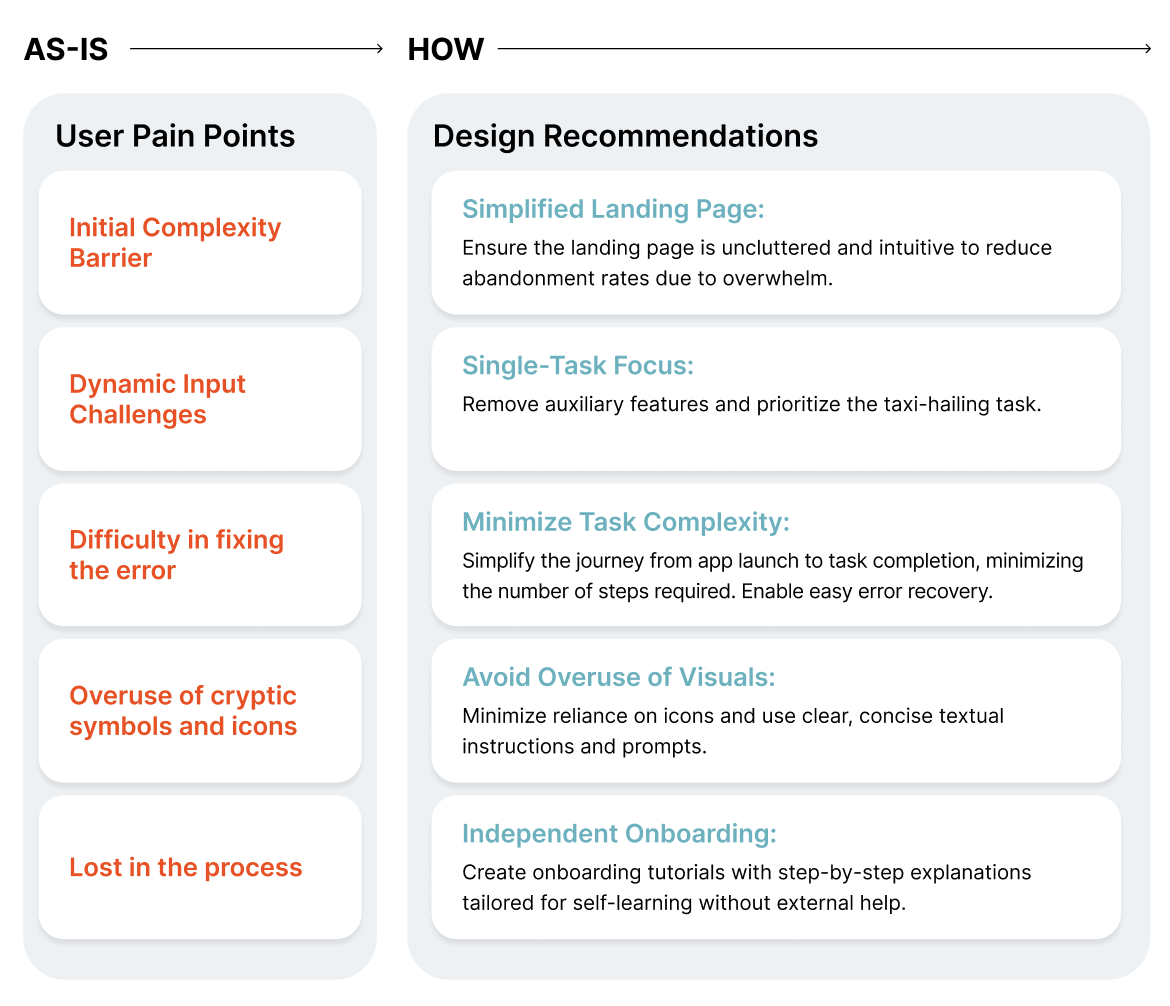
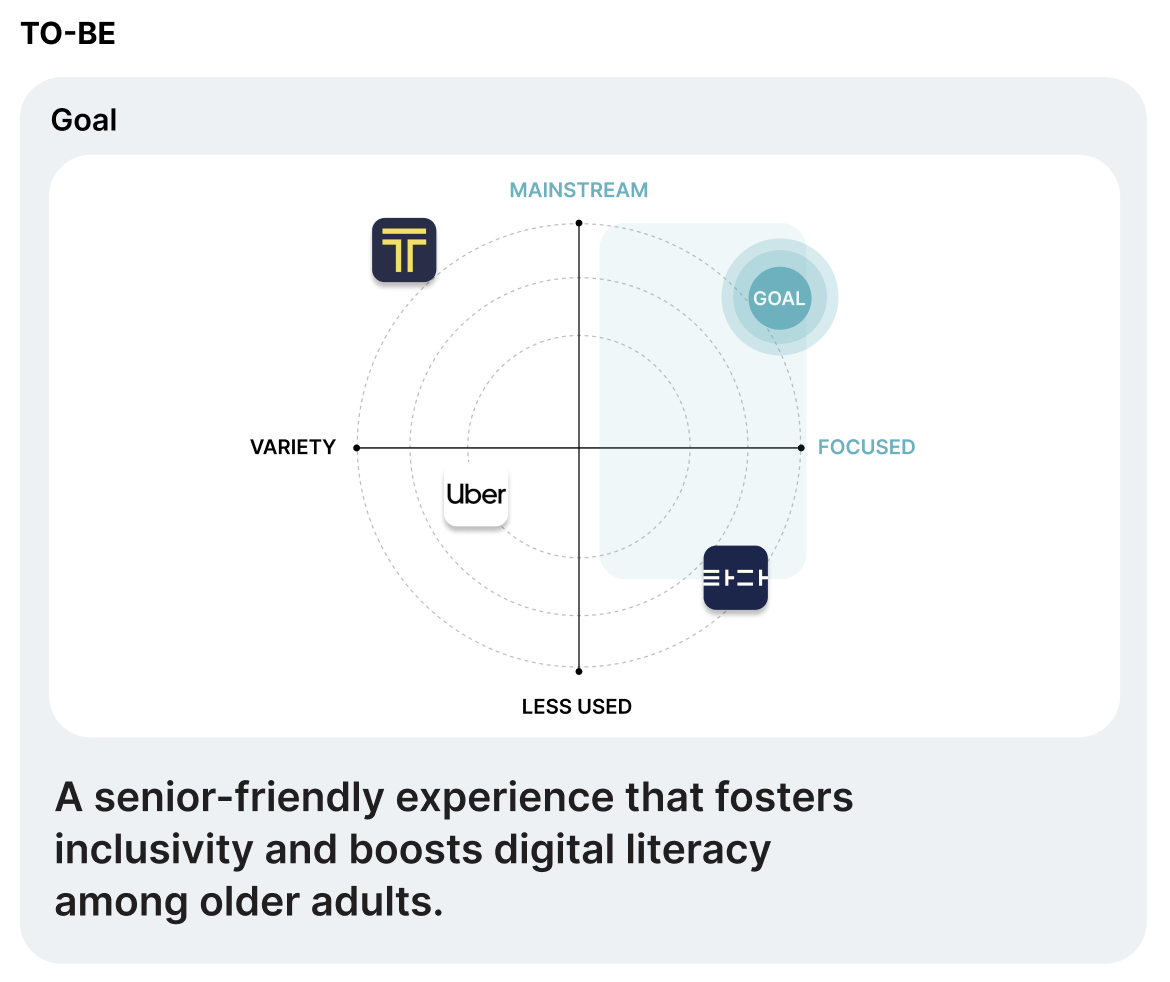
SYNTHESIS
Primary Persona
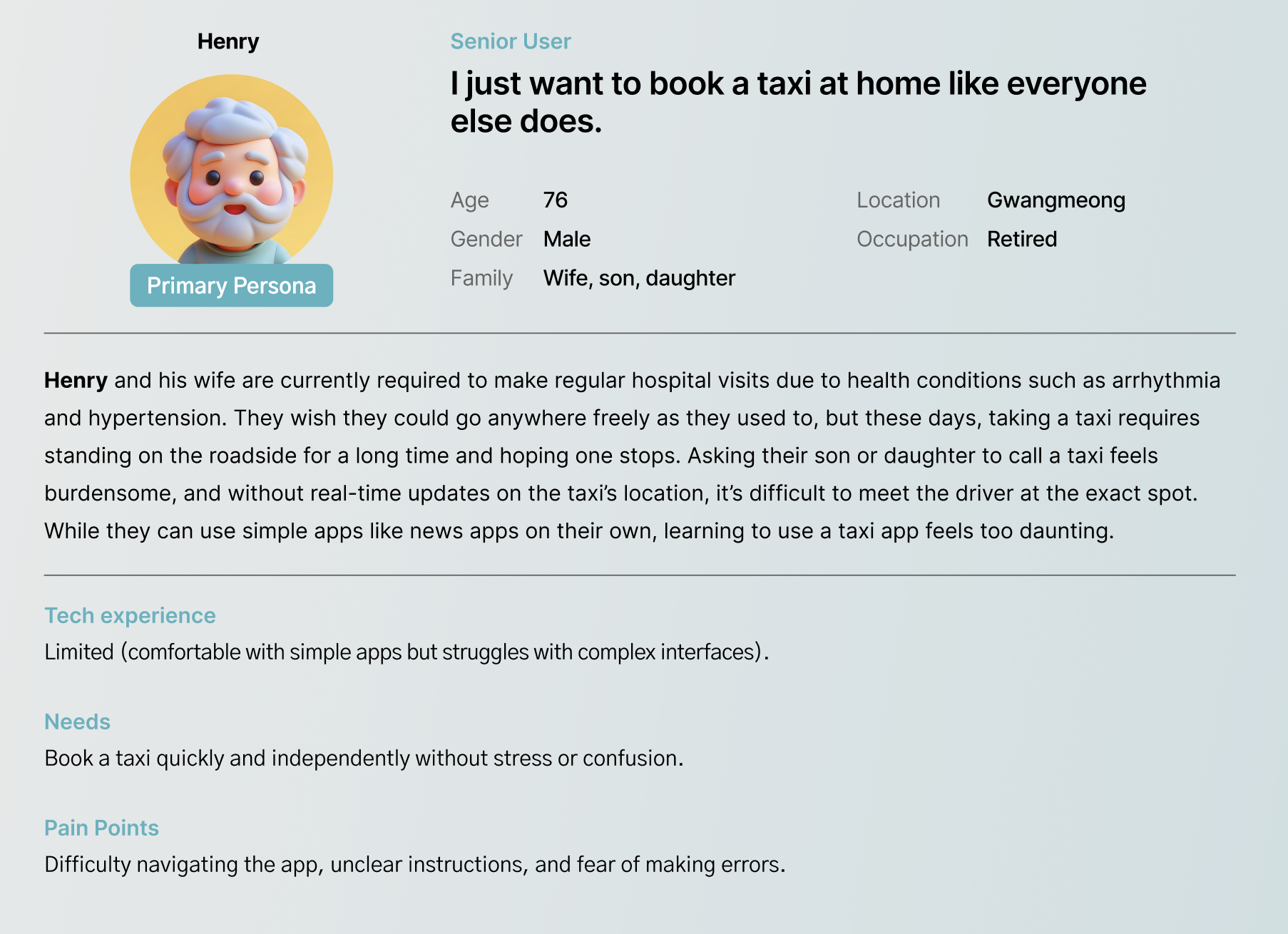
User Journey - Henry
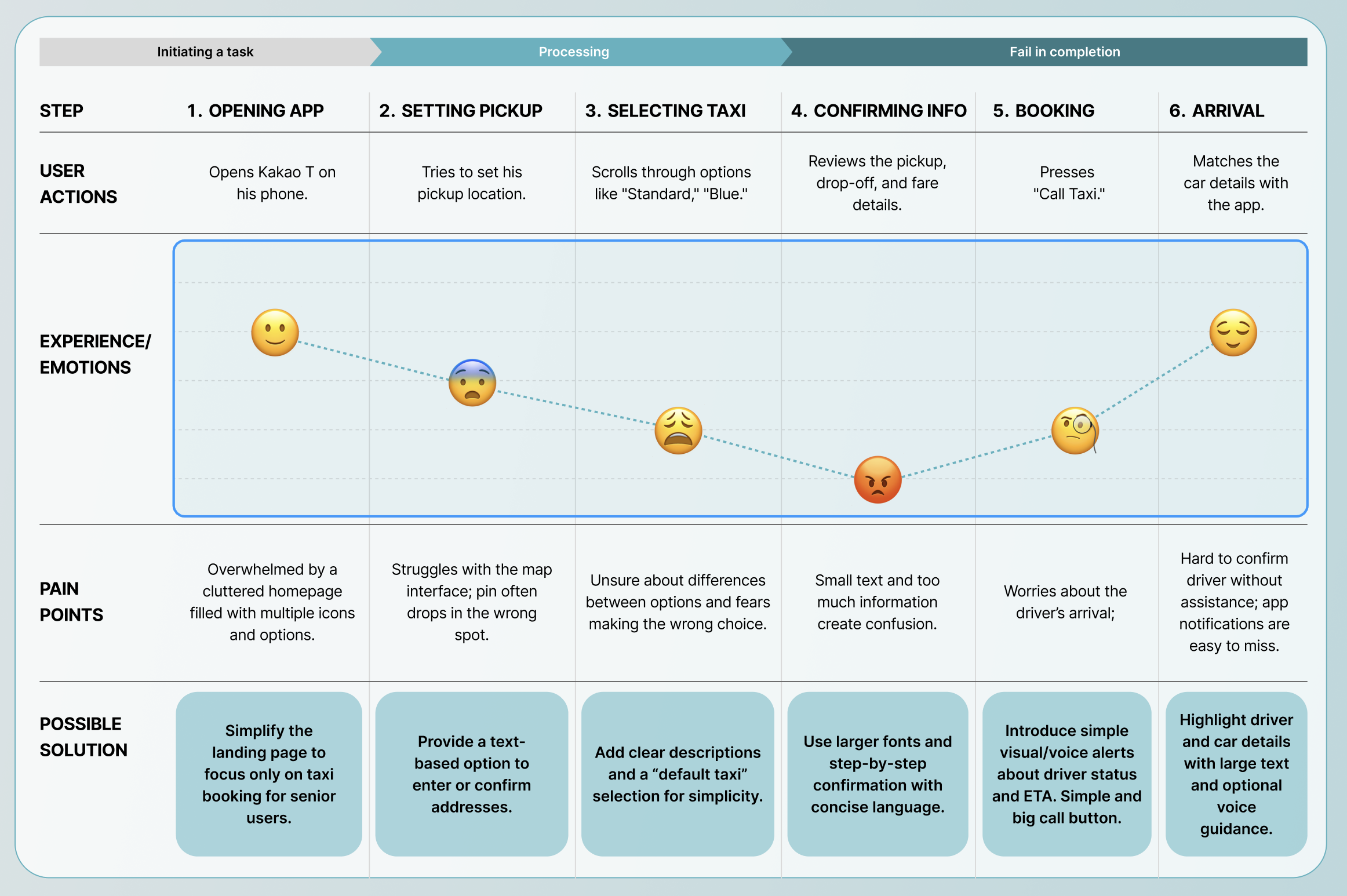
SYNTHESIS
Secondary Persona
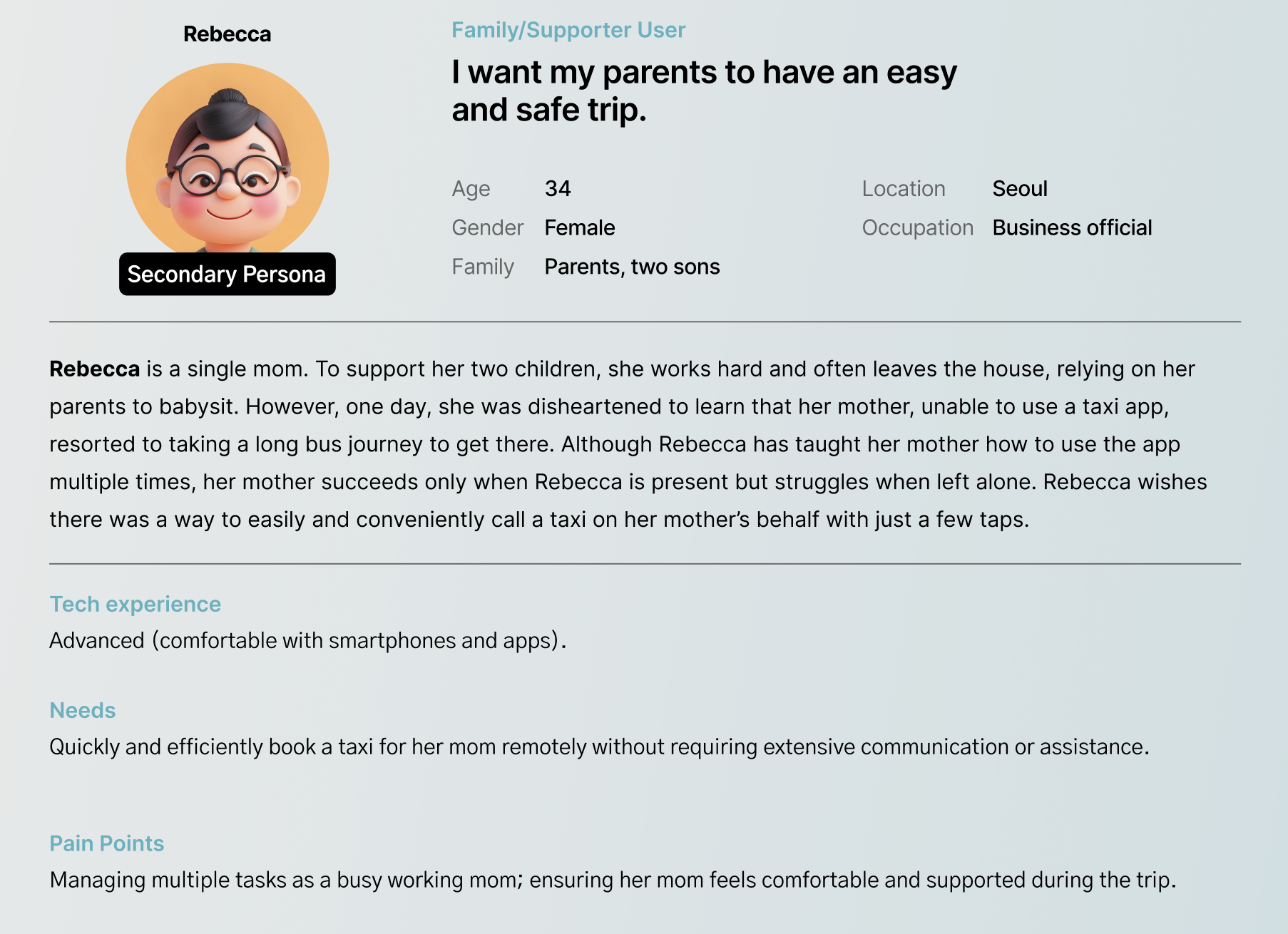
User Journey - Rebecca
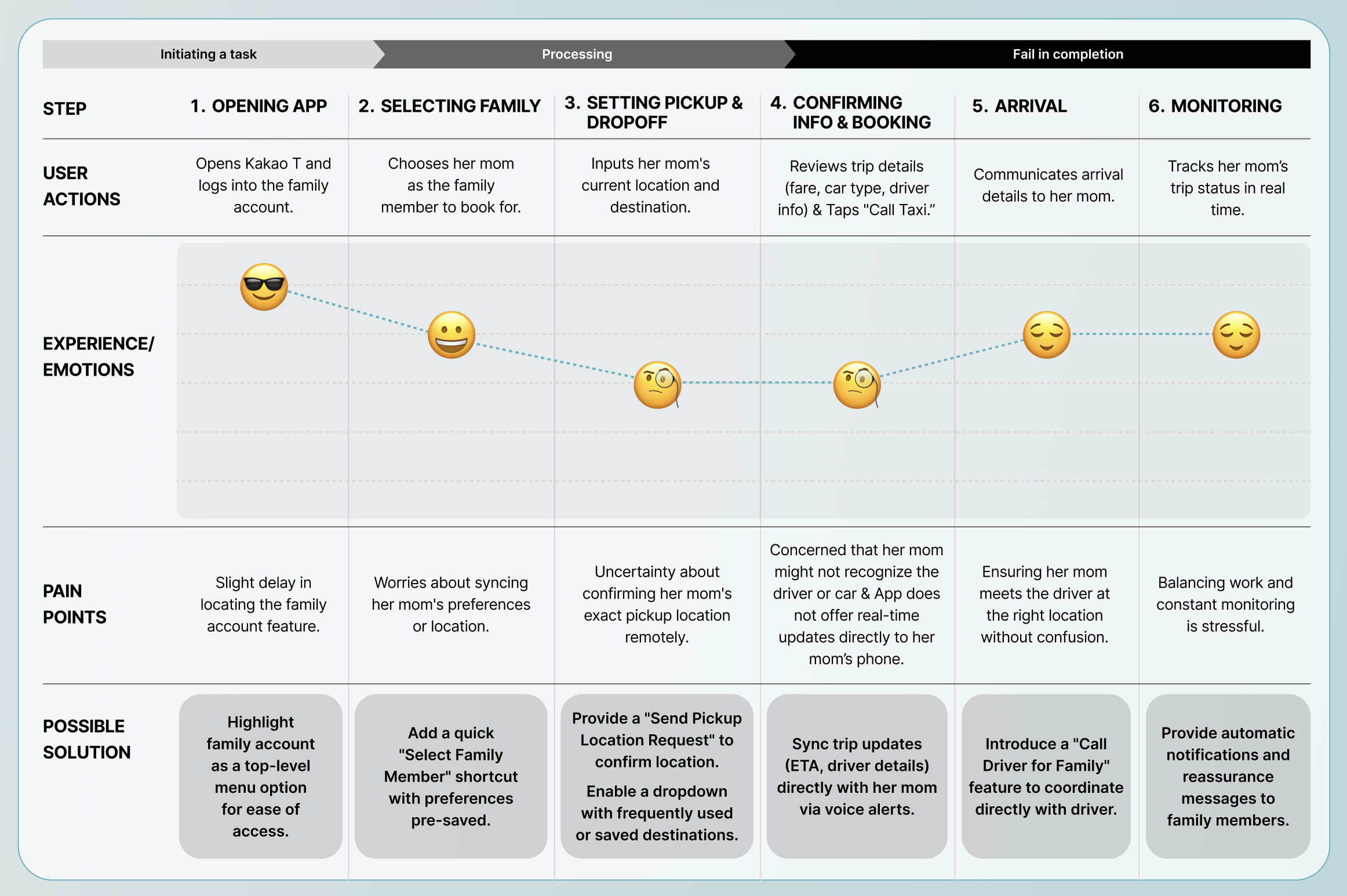
IDEATION
Possible Solutions
Based on the challenges faced by direct app user with cognitive and physical limitations and proxy user managing her mom’s needs remotely, the solution focuses on creating an inclusive, simplified, and intuitive experience.
︎ Design Goals
- Simplified Navigation: Minimize steps and reduce cognitive load by focusing on a single task at a time (e.g., taxi booking).
- Intuitive Interfaces: Use text-based prompts, large buttons, and a logical flow that caters to both novice users and confident users.
- Error Recovery: Provide clear, step-by-step guidance and easy mechanisms to undo or correct mistakes.
- Supportive Features: Include voice guidance, step-to-step tutorials and real-time communication tools for all users.
- Family Integration: Ensure seamless coordination between family members, allowing proxy users to assist easily.
Possible Senior user flow:
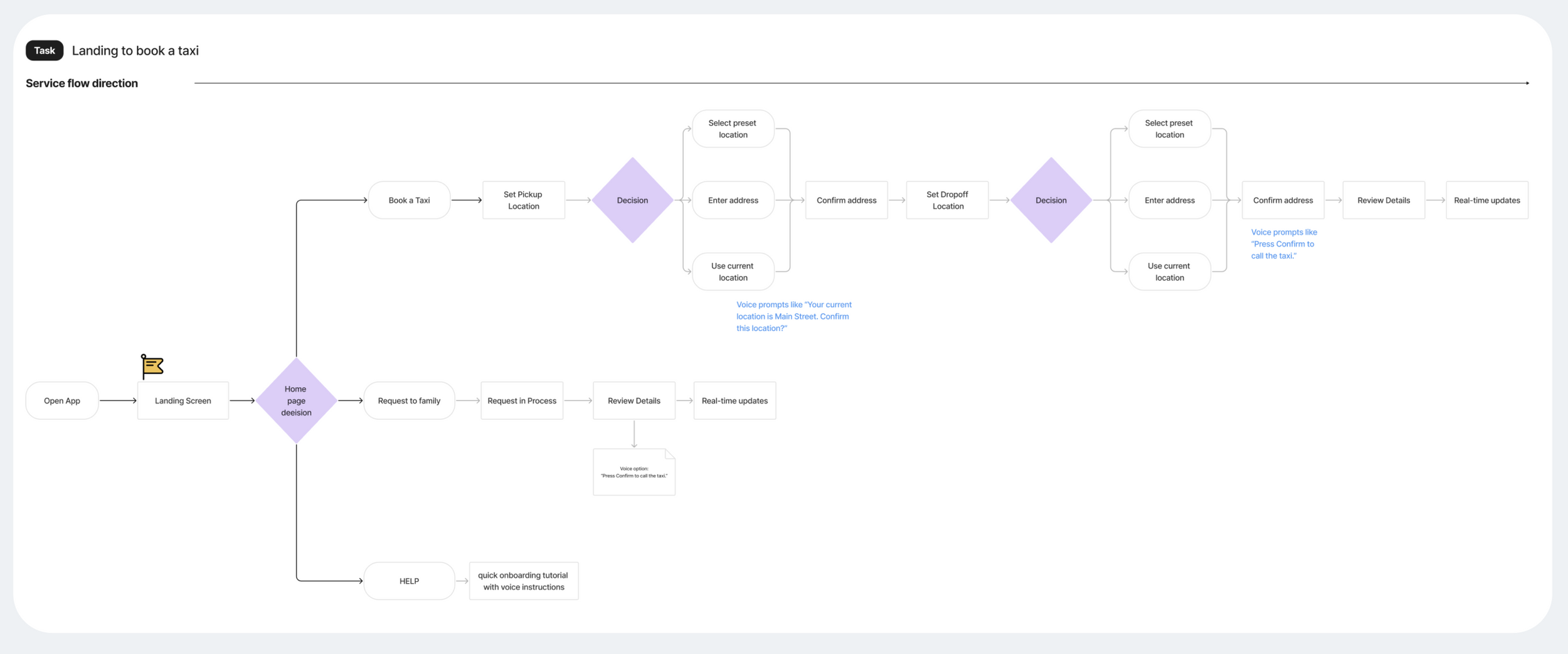
IDEATION
Information
Architecture

IDEATION
Information
Architecture

IDEATION
Low Fidelity Wireframe
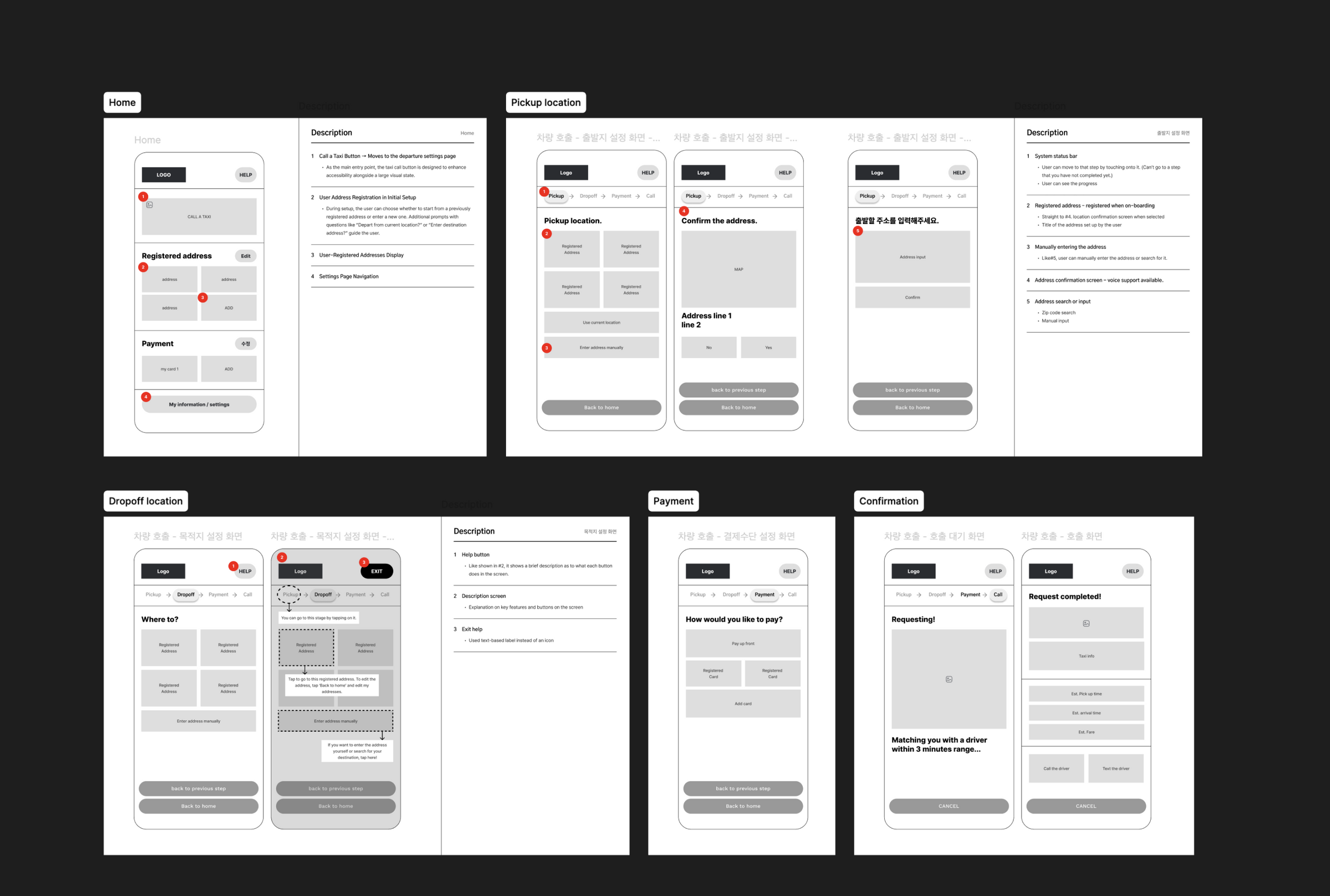
EXECUTION
Brand Identity

Colour & Typography:
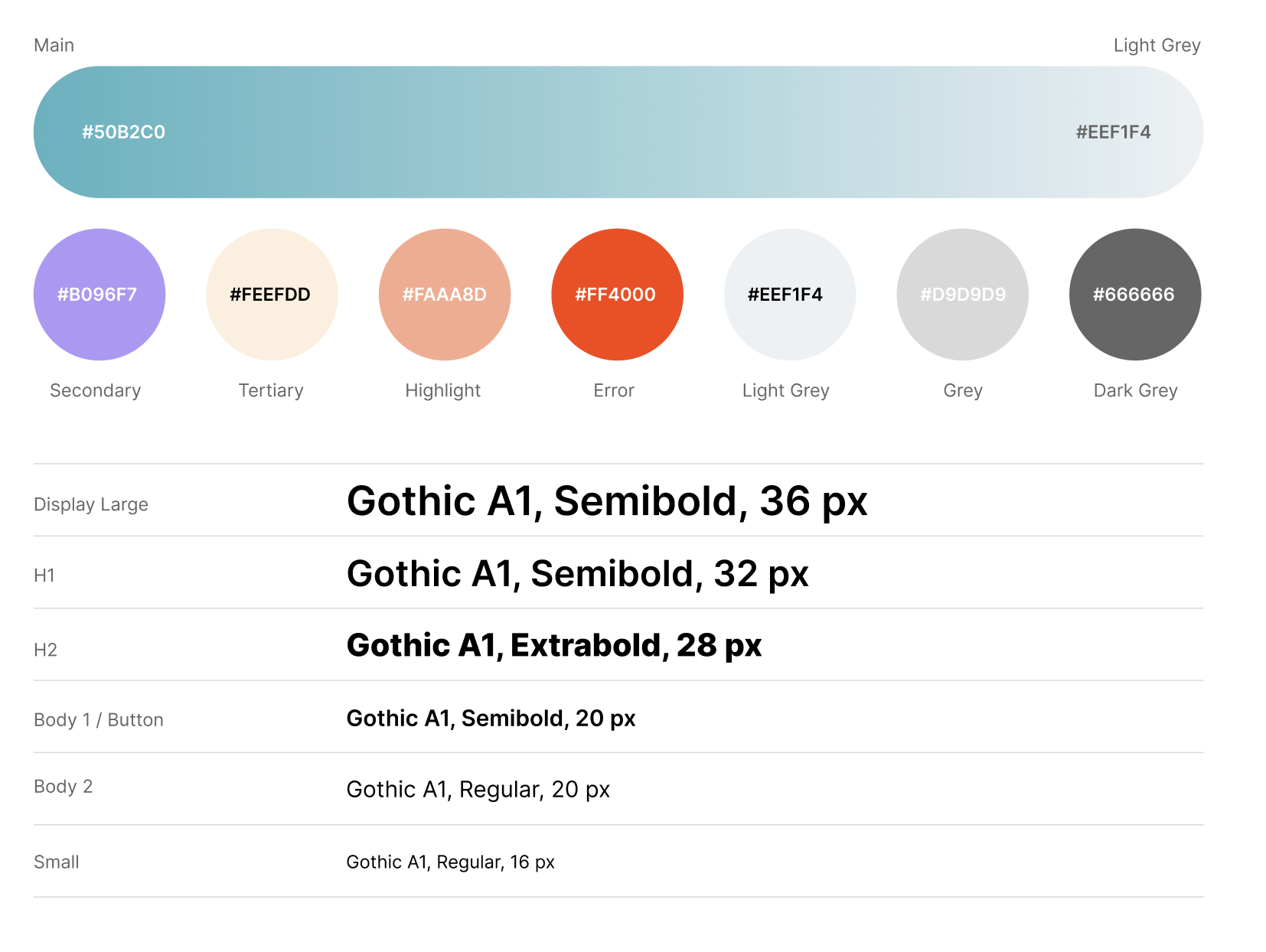
EXECUTION
High Fidelity
The high-fidelity wireframe reflects the culmination of user research and iterative design in redesigning the taxi app for seniors and caregivers.
Key challenges, such as overly complex navigation, inaccessible visuals, and lack of intuitive flows, were addressed.
The redesign prioritizes simplicity, clarity, and accessibility by introducing features like a streamlined home screen, pre-registered addresses and payment options, voice guidance, and step-by-step instructions.
This wireframe demonstrates a user-friendly interface tailored to ensure seniors can independently and confidently book a taxi while enabling caregivers to provide seamless support when needed.
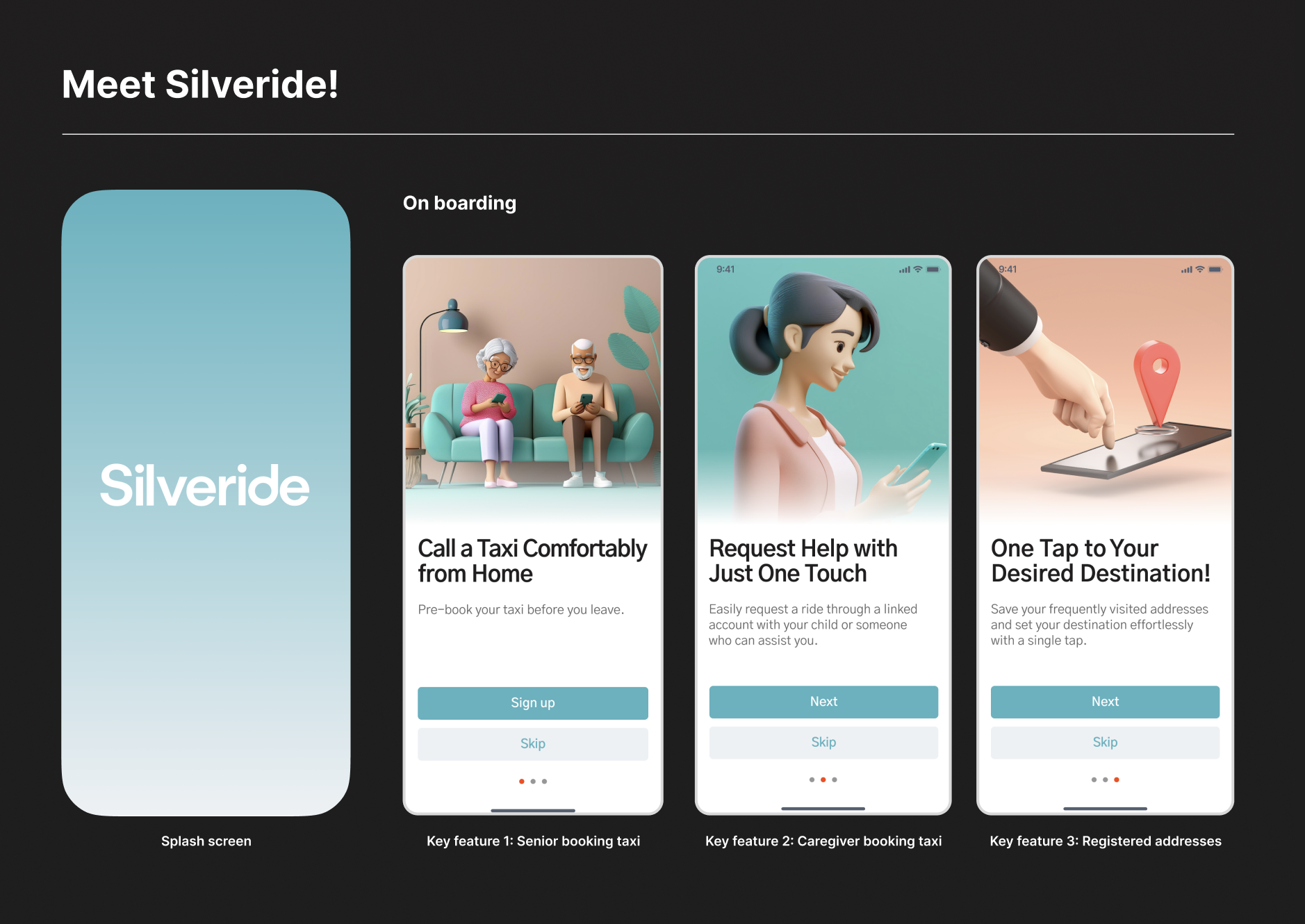
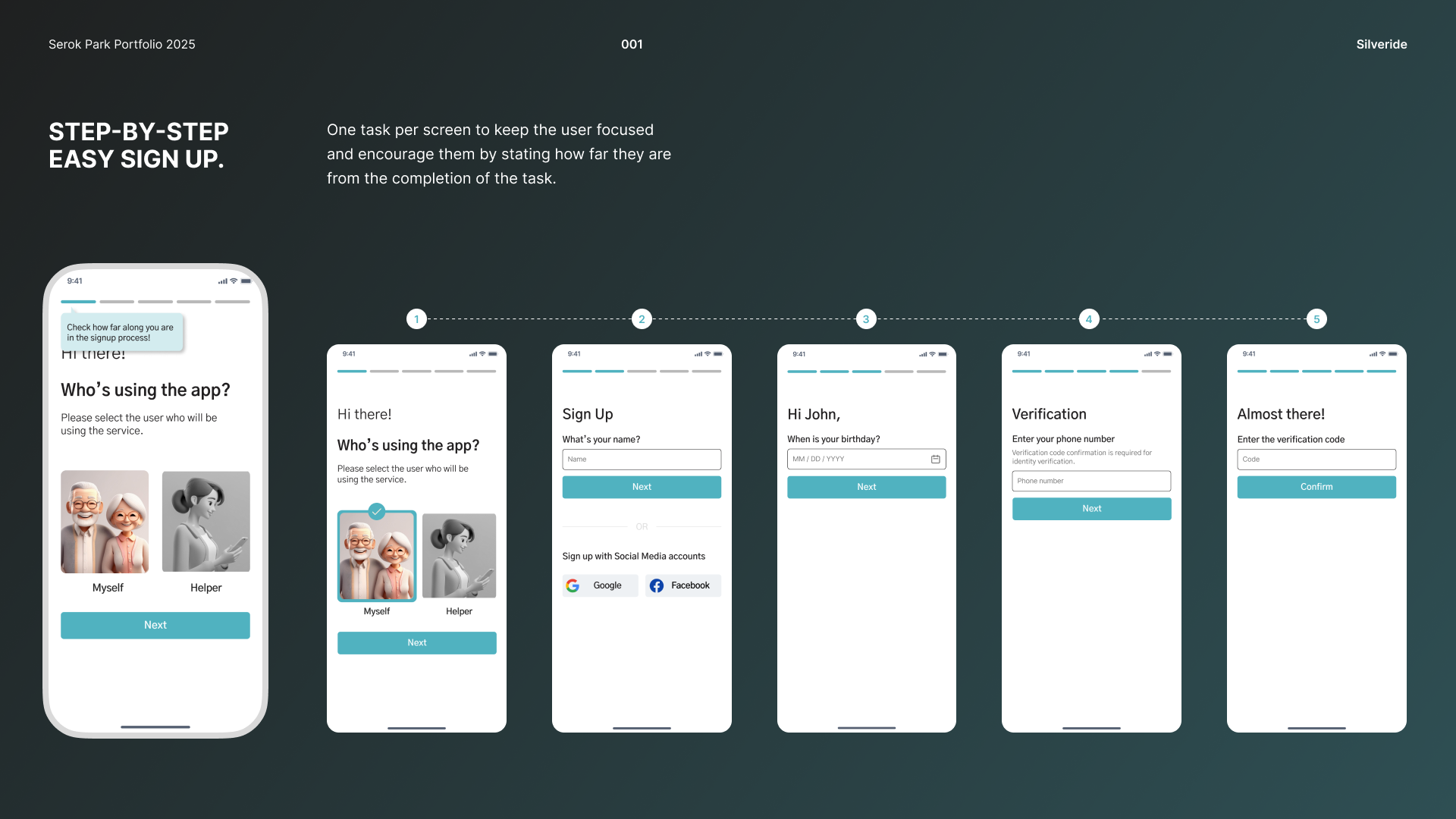
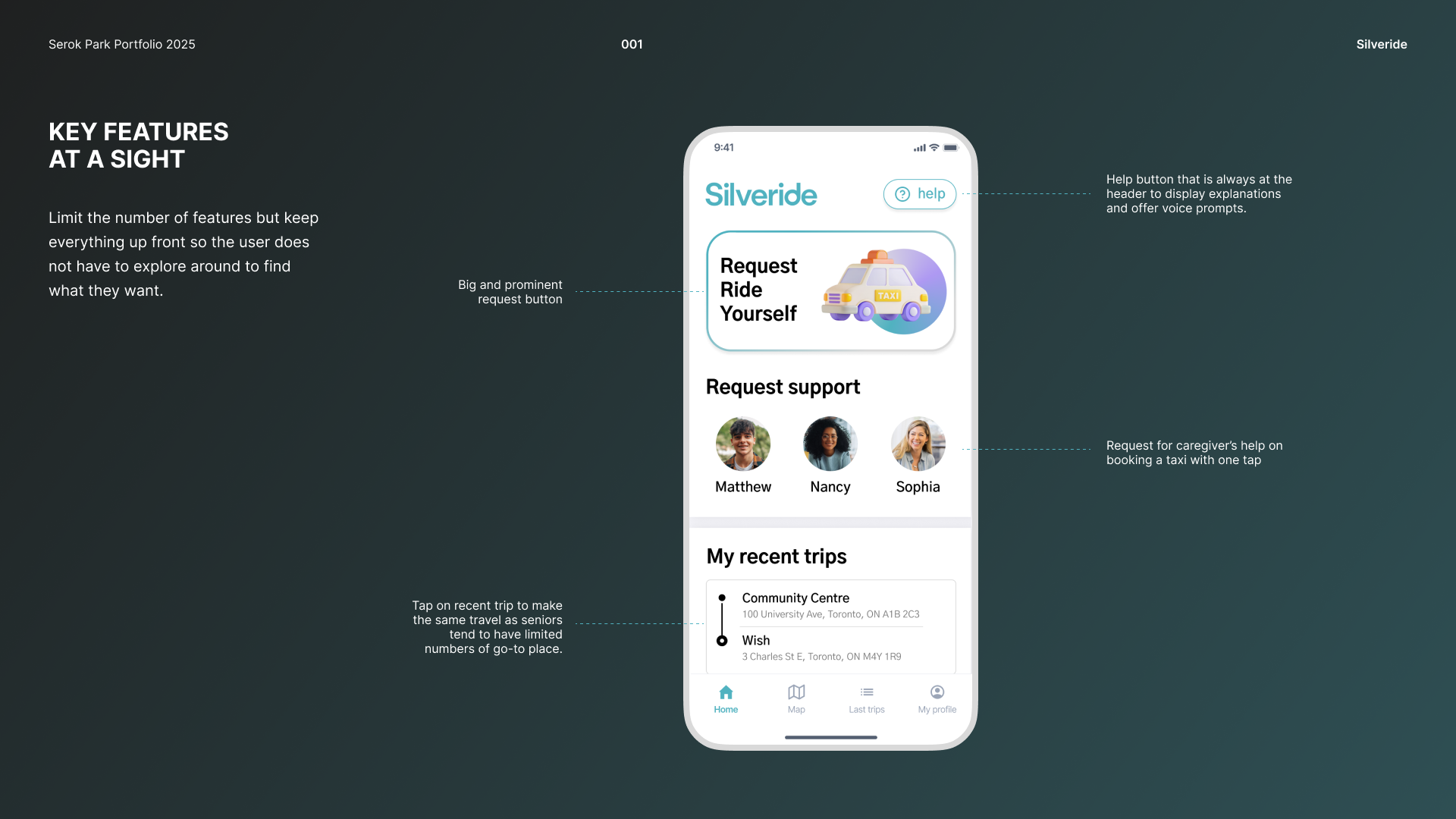
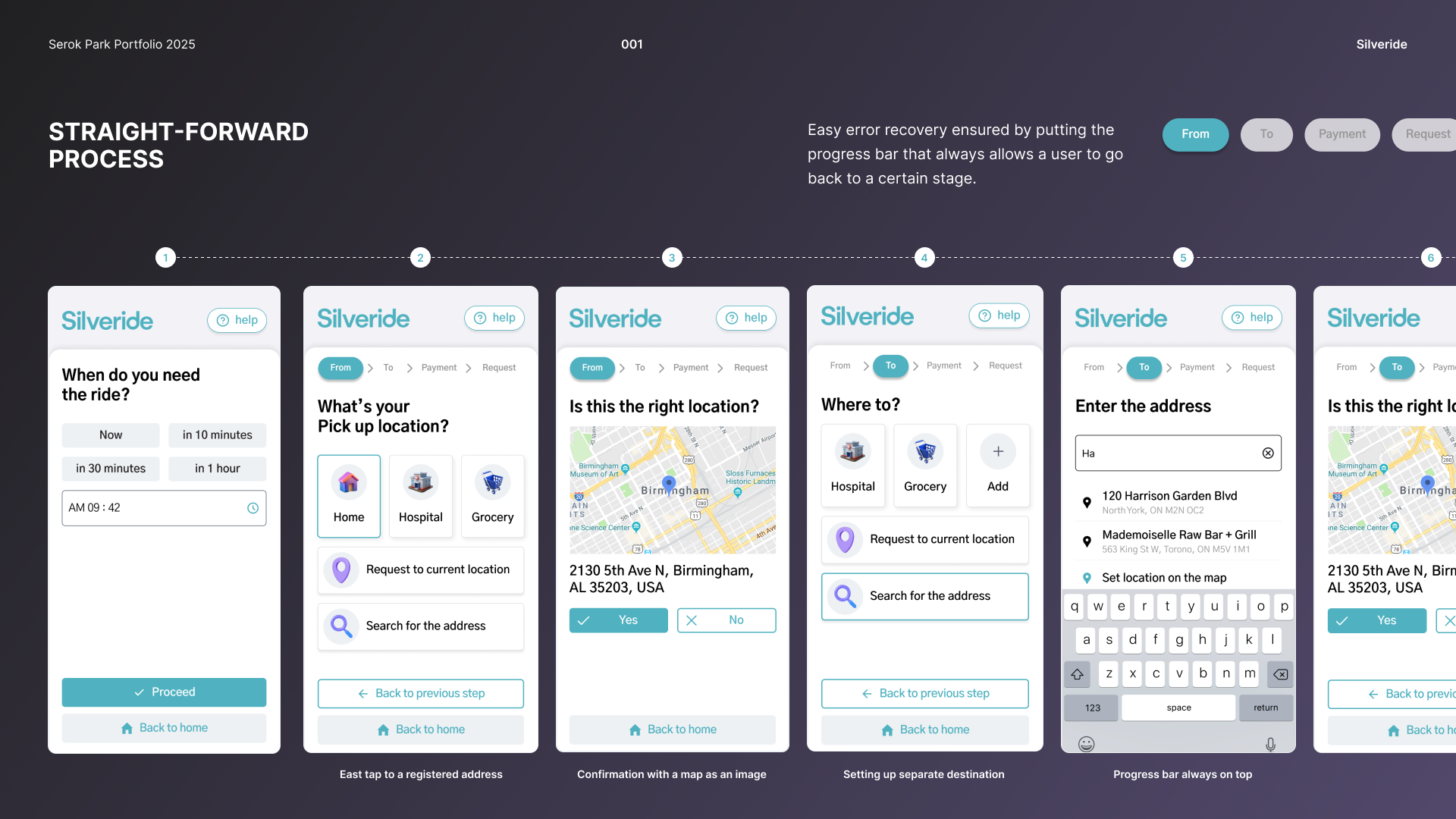
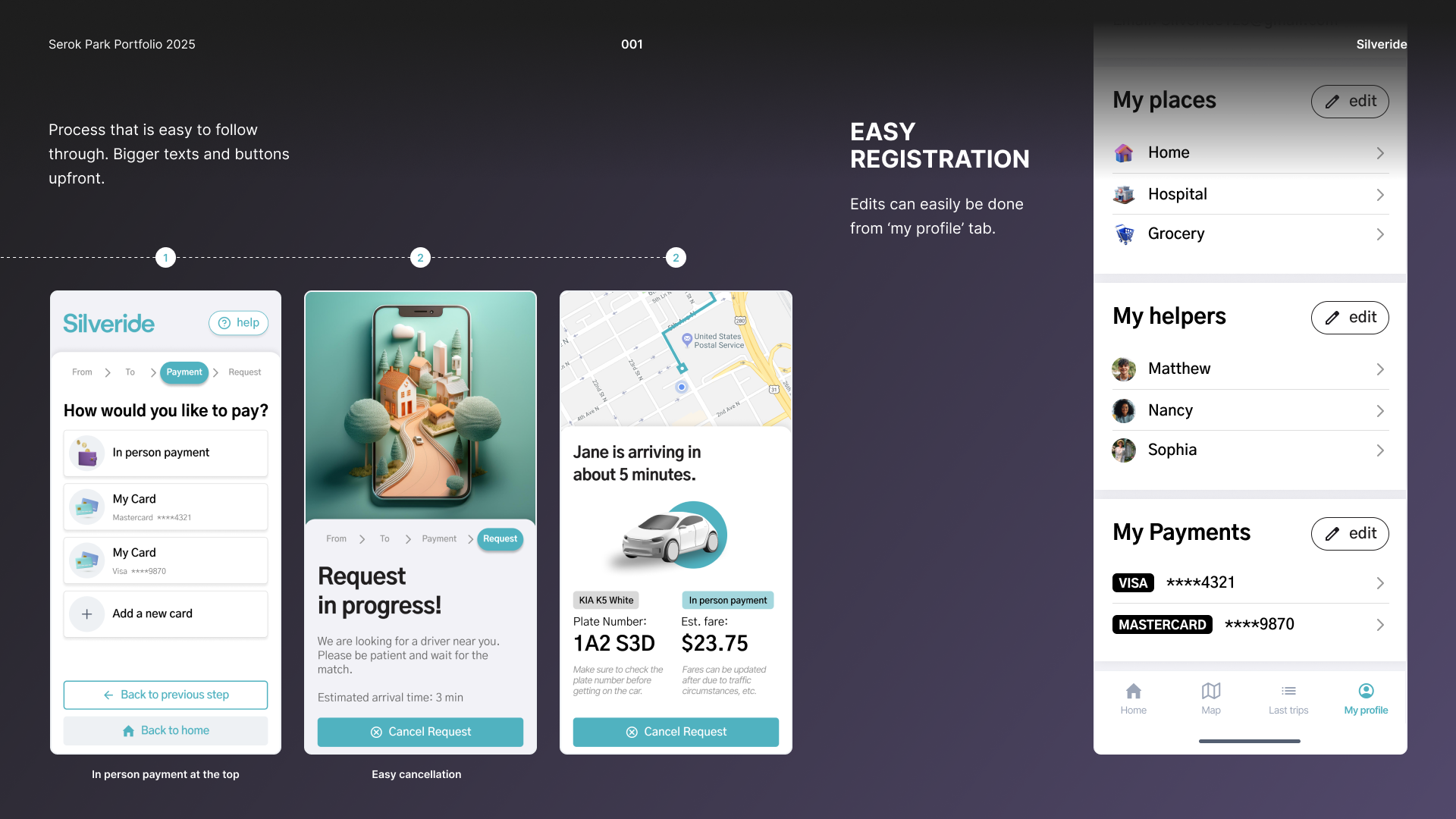
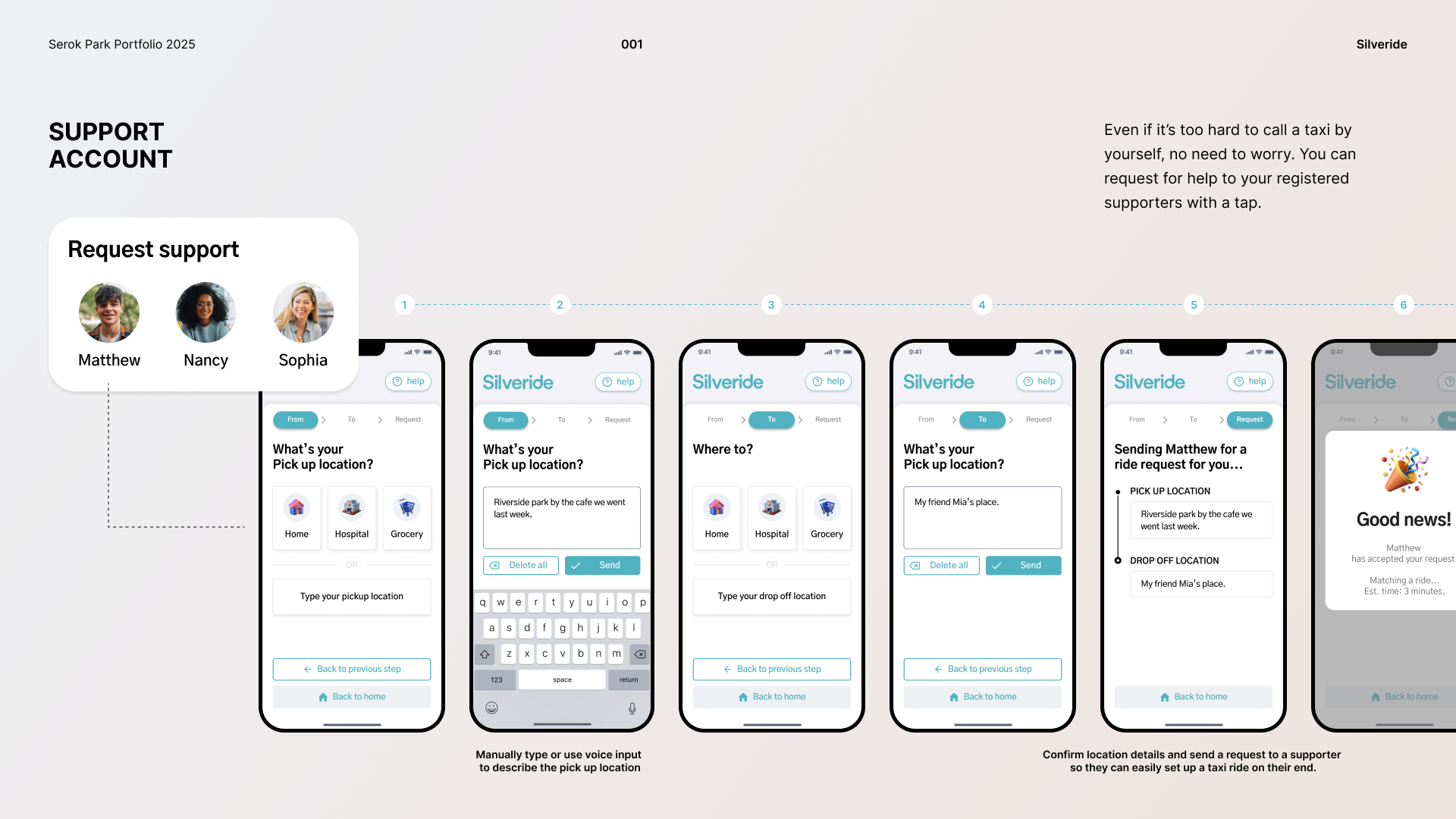
REFLECTION
Next Steps
MVT Testing
Conducting another set of interview after going through a minimum viable testing to see if the redesigned features are working better for the senior users.
- Recruitment & Pre-test Briefing
- Assign tasks to perform
Seniors: Book a taxi using pre-registered addresses and explore error recovery features.
Caregivers: Use the family account feature to book a taxi for a senior. - Observation
- Post-Test Feedback
- Data Collection
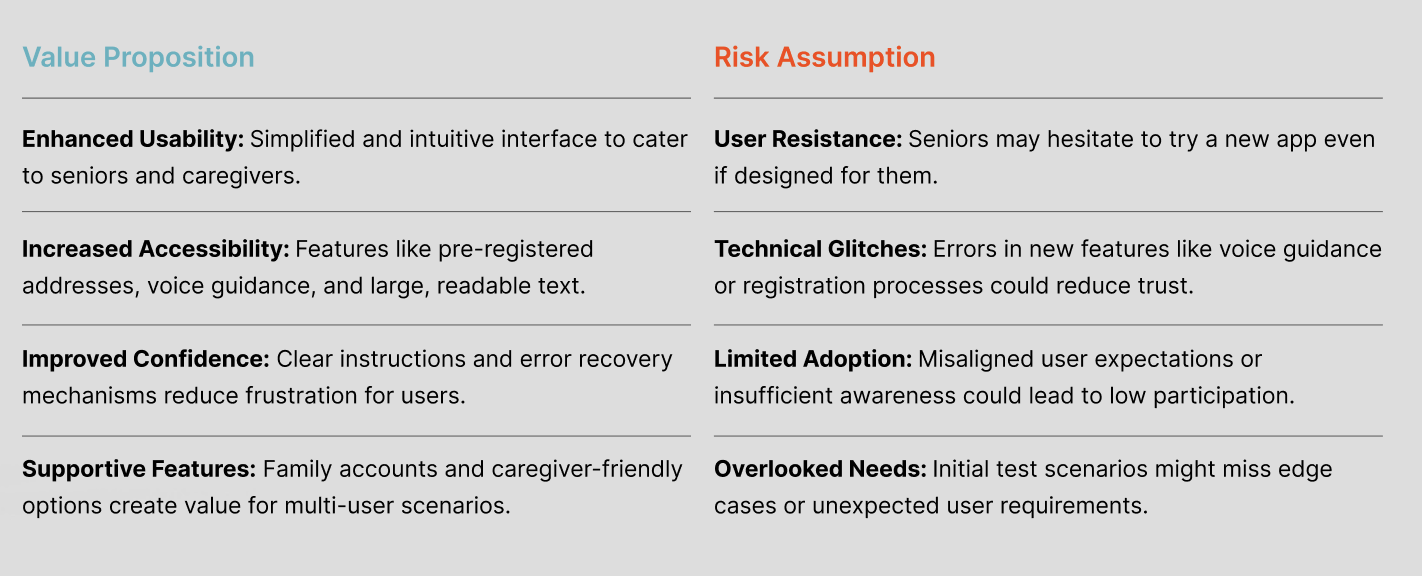
REFLECTION
Conclusions
This project tackled the critical challenge of making taxi booking apps more accessible and inclusive for seniors and caregivers. Through user research and iterative design, I focused on identifying key barriers, such as overly complex interfaces, lack of error recovery, and insufficient support for senior users with cognitive challenges.
Prioritizing simplicity, intuitive navigation, and tailored features – such as pre-registered addresses, family accounts, and voice guidance guided me to create a solution that empowers users like Henry and Rebecca to book taxis confidently and independently.
Personal reflection
During the two months I worked on this project, I learned and gained a lot. Personally, one of the most valuable realizations I had was the importance of asking myself, “Can I create a product that truly embraces and serves those closest to me?” as a product designer. If I can’t even address the pain points from those around me, how can I create a greater product that works for bigger group of people?
Through this project, I identified areas where I lack skills and need to improve and sparked my motivations, and it also sparked a deeper curiosity about how rapidly advancing technologies, such as artificial intelligence, can contribute to and enhance my work.
